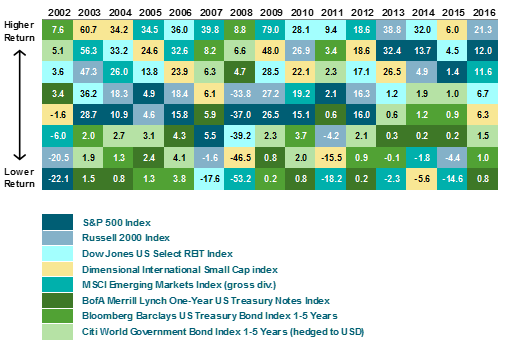The Diversification Challenge
You have likely heard many times about how important it is to be well diversified with your investments. Sayings like, "Never put all your eggs in one basket", make good intuitive sense and are easy to superficially apply to investing. And scary stories abound regarding companies that have gone bust while taking many a retirement fund with them. So, spread your eggs around in different baskets, don't chase "hot" stocks, strength in numbers... sounds simple, right?
But in practice being well diversified is a hard thing to do. Not technically, but psychologically. The reason is that portions of your portfolio will always be underperforming other portions. A popular stock might be dramatically outpacing a more traditional, slower-moving stock. The U.S. could be up while foreign stocks are down. Or, maybe it's the stock portion handily outperforming the bond portion. At any given point in time there will be winners and losers and they can change places rapidly.
It's natural when this occurs to want to sell the laggards and simply buy more of what's doing well, like that favorite stock, or a certain part of the market. The presumption often is that what's happening now is likely to continue, for better or worse. This so-called "recency bias" can lead investors to make potentially damaging decisions, such as trying to pick winners and losers, or otherwise trying to "time" the markets. But it's incredibly difficult, if not impossible, to predict accurately and consistently who the winners will be.
For example, review the following chart showing the performance of major indexes from 2002 through 2016. You may note that the best performer from year to year was only the same twice. Otherwise, performance was all over the place. In two of the years (2002 and 2008 – times of market turmoil) it was bonds that outperformed. Unless you develop a surefire way of predicting which of these areas will win the race each year, we need to own them all and focus instead on proportion and risk mitigation (aka asset allocation).

Say you drew an undulating line from left to right across the middle of this chart, representing your hypothetical portfolio performance. Your performance would have been much less volatile and more predictable, but would also never have made it to the top one or two rows due to the inclusion of a variety of chart components and "safer" investments, such as bonds. When stocks were way up, you would have underperformed. When stocks were way down, you would have performed better but still likely have seen red.
Being well diversified requires giving up some upside potential but the payoff should be a smoother ride over time. And the smoother ride is much more likely to get you to your long term destination.
Have questions? Ask me. I can help.
- Created on .



